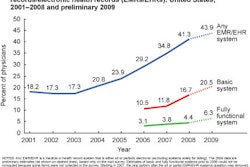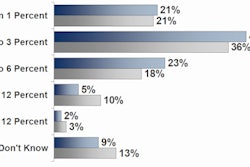Two hospitals in Sydney, Australia, installed the same oncology information system (OIS) at about the same time. The radiation oncology departments of both hospitals were enthusiastic and both had computer-proficient physicians and medical staff. Yet three years later, utilization was radically different. What happened?
One hospital had an ambitious goal -- the vision to go paperless -- and provided staff resources to make this happen. The other did not. The similarities and timing of the implementations made this an ideal scenario for a comparative analysis that has been published in the June issue of the International Journal of Medical Informatics (2010, Vol. 79:6, pp. 422-429).
While the factors identified by researchers at the Health Informatics Research Laboratory of the University of Wollongong, in Wollongong, New South Wales, are not revolutionary news, this comparative analysis reinforces the fact that technology does not necessarily succeed on its own merits. People are the key ingredient for success.
Background
The public hospitals, identified in the paper only as "A" and "B," were recipients of a grant from the New South Wales Department of Health to purchase and install OIS software (Lantis, Siemens Healthcare, Erlangen, Germany) in 2003. The two departments had a total of 15 radiation oncologists, the majority of whom were in their 30s and 40s, with comparable levels of computer literacy. The chairmen of both departments were radiation oncologists who provided a clear direction for the initial introduction of the hospital.
Objectives for the OIS were very different. In 2003, Hospital A was using a paper filing system, which the clinicians wanted to replace with electronic medical records. They believed that by going paperless, efficiency would be increased by enhancing communications, and availability and timeliness of information would also improve.
Hospital B was more advanced in 2003, using an in-house information system that handled patient booking. However, because the existing system could not incorporate radiation treatment data, the new OIS application was viewed only as a means to replace the old booking software with a new booking application that supported treatment data. Hospital B had no vision to go paperless, perceiving its primary task as transferring the old data to the new OIS.
Implementation strategies
Hospital A budgeted the position of project manager as an ongoing one, and selected a radiation therapist with good management and people skills as the project manager. She was responsible for providing training and support for every radiation oncologist. After the vendor trained a group of super-users, a super-user was designated as backup when the project manager was absent.
The project manager was supported by a project committee consisting of two medical physicists, a hospital IT staff member, and the head of the radiation oncology department as chairman. After implementation, a meeting was held weekly to review recommended changes, revisions, and updates, and users would be kept appraised and trained on changes on an ongoing basis.
Use of the OIS was compulsory. The software was the sole documentation system for radiation oncologists, therapists, medical physicists, and nurses. Oncologists directly entered clinical notes into the system on a daily basis, and examination rooms were equipped with computers for this purpose.
Workflow changes were ongoing, with additions and improvements discussed first by the project committee and then by the radiation oncologists and staff to determine how workflow would be impacted. By 2005, all radiation prescriptions and bookings were done on the system. By 2007, Hospital A's radiation oncology department staff members were recording patient history and examination results, noting diagnoses, prescribing and approving radiation treatment, recording acute side effects, and tracking disease outcomes and acute late toxicities.
When interviewed in 2007, the clinicians were very pleased with the overall implementation and their utilization of the system, and looked forward to its continued development to improve workflow and data quality, according to lead author Dr. Ping Yu. Hospital B clinicians were also pleased with their system, but felt that it was underutilized and a guarded success. Their actual use was radically different, a subset of what Hospital A's department had achieved.
Hospital B's experience
Hospital B implemented administrative functions of the OIS in 2004. These included patient booking and tracking and adding patient diagnoses. An IT professional was selected as project manager, and the project management committee included radiation therapists and medical physicists. The hospital's information systems department was responsible for resolving technical problems, but no specific staff person was responsible for ongoing clinical implementation and software maintenance.
Utilization was not compulsory at Hospital B. When the radiation oncologists refused to enter clinical data, the committee decided that data entry should be performed by clerical data entry staff. After the project manager completed the transfer of data from the old database to the new system, he resigned and was replaced by a part-time staffer to manage system access rights and other operational functions. There were no designated super-users to support this staff person, especially with respect to providing additional training.
Without a central leader, and having achieved the initial goal, the visibility of the project was low. Additionally, the position of department head was vacant for a two-year period between 2004 and 2007. The project stagnated without leadership, even though the project management committee continued to meet monthly to solve problems for health professionals other than the radiation oncologists who used other functions within the OIS. Radiation oncologists interviewed by the authors blamed the project stagnation as lack of effective leadership after the initial introduction of the system.
Centralized data entry by clerical staff and lack of computers in examination rooms for motivated clinicians to enter exam data also were barriers to use by radiation oncologists. Unlike their counterparts in Hospital A, they had little interaction with the system, experienced few benefits firsthand, and did not speculate as to what improvements should be made or new functions added.
During one-on-one interviews, most radiation oncologists at Hospital B stated that the system was an improvement compared to what had previously existed. One commented that by being able to access appointment data, it was possible to anticipate how long clinics would take on a daily basis and plan accordingly. They were able to do this more rapidly and easily than with a paper-based system. Unfortunately, clinical functionalities such as patient history, examination results, and radiation prescription and review were never implemented.
Current status
Dr. Andrew Miller, a radiation oncologist at Illawarra Cancer Care Centre in Wollongong and one of the study's authors, told AuntMinnie.com in an e-mail that Hospital B is taking the opportunity to start afresh when it upgrades to the latest version of the OIS software.
A new radiation oncologist is head of the department, and a full-time project manager has been employed. The radiation oncologists are supportive of a broader implementation of the software, and training and hands-on access will be available to oncologists, radiation oncologists, hematologists, and allied health staff. Hospital B plans to learn from its experiences and not repeat them.
Hospital A is in the process of installing the same major software upgrade. It's encountering new software problems but is endeavoring to find workarounds. "The accumulated data availability in the database of cancer patients is breathtaking," Miller wrote.
By Cynthia E. Keen
AuntMinnie.com staff writer
May 7, 2010
Related Reading
Keeping your eye on the PACS ball, September 30, 2003
Smoothing the transition to filmless, June 16, 2003
Copyright © 2010 AuntMinnie.com



















